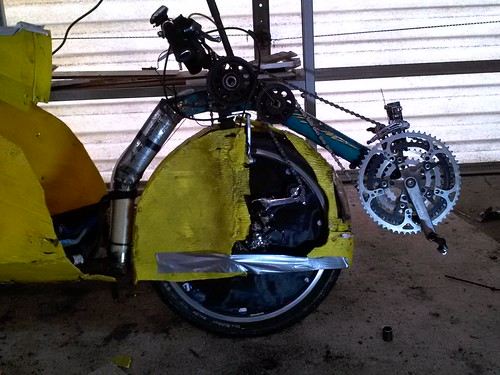Hi,
I am aware of Matts designs, well ahead of his time. With a high cross wind, the bike is a an angle leaning into the wind, and the faster you go the more it pushes, 30+ mph with the brakes on. Anyway, the best is when the CP and CG are close, but in a faired bike the CP is usually ahead of the CG. I once had ny LWB pretty well balanced in cross winds, then I added touring gear behind the seat, moving the CG back. Even though the bike was heavier, it was less stable.
Ive heated crank arms with a propane torch, then pry it up an the same time hitting the aluminum near the square taper with a hammer and it will pop off, that is if the threads are messed up where the crank arm puller wont work. Heating with the puller works too.
This is the FWD of the SWB: Note the 4 chain rings

From IHPVA archives:
Sidewind Stabilization
A final factor that strongly effects the controllability of a streamlined bicycle is sidewinds. Those familiar with using front-wheel disks know that side winds can produce some unpleasant torques on the steering. Similar, yet much worse, are the lifting forces on a typical streamlined bicycle moving along in excess of 40 mph.The force vector points predominantly to the side and slightly forward. This means you might get propelled forward a little, but most likely you'll get blown over.There is neat solution, however. Ifound that by properly setting the geometry of the bicycle relative to the fairing and its associated center of pressure (the imaginary point on the fairing where the resultant aerodynamic lift force acts), the bicycle will automatically lean into a good range of side winds. This results from steering torques induced by wind pressure, causing the bike to momentarily steer away from the wind, and thus generate a lean into the wind. The trick is to try to tune this as best possible. The numerical model discussed previously can be used to analyze this, where the configuration of such a bike is characterized by the front wheel being relatively far back from the nose. The Cutting Edge approximates this; however, it actually over compensates a little -I find myself gently steering out of a lean into the sidewind.
So the bike " momentarily steers away from the wind". yes this is not ideal in heavy winds. I always have to steer into the wind, other wise the bike will blow over.